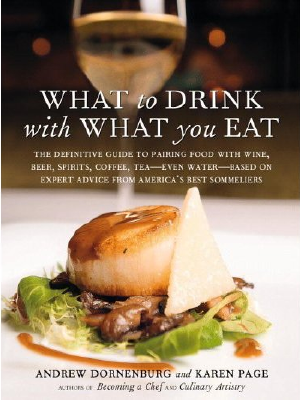A couple of months ago, I reconnected with Ken, one of my college roommates. Turns out that 25 years after rooming together, he and I gain live in the same building.
Over dinner at Relish Gastropub — one of my favorite new restaurants in Portland — Ken and I reconnected. We talked about life and love. We talked about money. We talked about food. In the decades since I knew him, Ken has become a professional chef. In fact, he teaches restaurant management at one of the culinary schools here in town.
At one point, the conversation turned to books. “I used to have thousands of books,” I told Ken. “I still have too many. But moving into my new place has forced me to do yet another book purge. If Kim moves in with me, I may have to get rid of even more.”
“Yeah,” Ken said. “I love books too. Especially cookbooks. I have a cookbook problem.” We laughed at the notion he was addicted to cookbooks.
“You know,” I said, “I’ve been doing more cooking now that I have a decent kitchen. I like cooking, but I haven’t done much of it since Kris and I split up. Do you have any cookbook recommendations?”
Ken thought for a moment. “Actually, my favorite cookbook — the one I use all the time — isn’t really a cookbook. It’s called The Flavor Bible, and all it does is list hundreds of different flavor combinations that work well together. I use it as a source of inspiration. Like, if I have beets in the fridge that I need to use, I can look in The Flavor Bible to see that good flavor combinations are beets and butter, or beets and blue cheese, or beets and dijon mustard. It even lists complex flavor combinations such as beets and vinegar and hazelnuts and Gorgonzola.”
“Huh,” I said. “Sounds like my kind of book.”
The Flavor Bible
 The next day, I borrowed a copy from the library. I liked it. Not only does The Flavor Bible list matching flavor combinations, it also tells you which flavor combinations to avoid (don’t mix basil and tarragon, for instance). It offers tips and ideas from great chefs around the United States. Some of the tips are short and sweet, like this one from Emily Luchetti of San Francisco’s Farallon:
The next day, I borrowed a copy from the library. I liked it. Not only does The Flavor Bible list matching flavor combinations, it also tells you which flavor combinations to avoid (don’t mix basil and tarragon, for instance). It offers tips and ideas from great chefs around the United States. Some of the tips are short and sweet, like this one from Emily Luchetti of San Francisco’s Farallon:
Blueberries and lemon go really well together. Blueberries are a thick fruit with a lot of pectin in them, and intensely flavored. You need som lemon to cut through that.
In the blueberry section, there are quotes from other chefs that suggest using cinnamon or maple in combination with blueberries.
Other tips are longer. For example, The Flavor Bible includes a sidebar in which Gina DePalma of New York’s Babbo describes how to build a cheese plate. As a guy who likes his cheeses (and likes to build cheese plates), these 250 words are gold.
Though The Flavor Bible doesn’t contain any actual recipes, it does list hundreds of dishes from restaurants around the country, such as:
- Alaskan king salmon with sugar snap peas
- Cornish game hens with pomegranate sauce and toasted almonds
- Leek and asparagus pasta with lemon, parmesan, and poached egg
- Seaweed and jicama salad with ginger dressing
- Roasted beet salad with shaved fennel and chèvre
The names and descriptions of these dishes are often enough for inspiration. (Plus, you can sometimes google to find a recipe.)
Sometimes a chef will describe a dish in detail (though not with an actual recipe). I’m eager to try Gabriel Kreuther‘s watermelon salad, which includes a tomato confit and a layer of browned pistachios with salt and pepper. Sounds delicious.
Since I bought this cookbook a month ago, I’ve used it several times each week. Like my friend Ken, I grab The Flavor Bible whenever I have spare food in the fridge that I need to know how to use. Sometimes I use it to figure out how to add another dimension to something I’m making.
Here’s an example. For the next three weeks, Kim and I are doing a plant-based “cleanse” together (with a small portion of lean protein in the evening). As Kim (and Kris) will tell you, I’m not so good when it comes to eating plants. I need help getting creative with them. That’s where The Flavor Bible comes in.
Yesterday I used it for something as simple as a fruit smoothie. I’d already added banana, coconut milk, berries, and vanilla protein powder. “What can I do to punch this up?” I wondered. “Maybe cinnamon?” I pulled down The Flavor Bible. Sure enough, bananas and vanilla combine well with cinnamon, and berries are on okay flavor match. I added a bit of cinnamon to the smoothie and it helped.
The 39 Best Flavor Combinations
The Flavor Bible contains nearly 400 pages of flavor affinities, which it ranks on four levels based on how many chefs recommend the combination. Of these thousands of permutations, I scoured the book to find only 39 that received the highest number of endorsements. These are the “Holy Grail” flavor pairings that the most experts agree upon. Here they are:
- Angelica and rhubarb
- Apple and cinnamon
- Basil and garlic
- Basil and tomatoes
- Beans and savory
- Beans (flageolet) and lamb
- Chard and garlic
- Cheese (manchego) and quince paste
- Cherries and kirsch
- Chile peppers and Thai cuisine
- Chocolate and coffee
- White chocolate and raspberries
- Crab and avocado
- Jicama and chile peppers
- Jicama and lime
- Lamb and garlic
- Lamb and rosemary
- Mint and lamb
- Oregano and tomatoes
- Pork and black pepper
- Quince and apples
- Quince and pears
- Raspberries and white chocolate
- Rhubarb and strawberries
- Rosemary and garlic
- Rosemary and lamb
- Saffron and rice
- Saffron and risotto
- Savory and beans
- Shrimp and garlic
- Spinach and butter (especially unsalted butter)
- Strawberries and cream
- Strawberries and rhubarb
- Strawberries and sugar
- Strawberries and balsamic vinegar (especially aged balsamic vinegar
- Tomatoes and basil
- Turmeric and curry powder
- Vanilla and (ice) cream
- Fennel seeds and sausages (especially Italian sausages)
I find it interesting that a handful of flavor combinations appear in the listing for both ingredients (strawberries are recommended with rhubarb and rhubarb is recommended with strawberries), but most of the pairings are only uni-directional. Not sure what that means.
The Bottom Line
 If I have one complaint about The Flavor Bible it’s that the highly-recommended flavor matches tend toward the conventional. I wonder if they’re recommended not so much because they’re great combinations but because they’re well known.
If I have one complaint about The Flavor Bible it’s that the highly-recommended flavor matches tend toward the conventional. I wonder if they’re recommended not so much because they’re great combinations but because they’re well known.
Still, I have to agree with Ken. The Flavor Bible is a great book, and I can see keeping it in my kitchen long after other cookbooks have been donated to Goodwill. I look forward to many years of exploring its suggestions. I’ll start tonight. Kim and I are going to try some jicama with chile peppers and lime!
The authors of The Flavor Bible also wrote a book called What to Drink with What You Eat, which apparently follows the same format. Guess what I’m going to borrow from the library when I run my errands today…

Now that we have the internet available for cooking, this really is a great tool to become creative in the kitchen. I bet as time goes by you’ll get better at making up (or remembering) your preferred combinations. I often go to the grocery store and pick a couple of ingredients, then brainstorm how I can use them. For example I’ll feel like spinach, and it might be a warm night, so I’ll decide lemon/feta/pasta. Or I might go the other direction on a chilly evening and choose garam masala/chick peas/rice. A lot of it comes with time and practice! Of course this opens me up to the dread shopping without a list, which is a whole different problem.
I also have learned to taste something and try to assess what it needs: sweet/acidic/spicy/salty/zesty? I’d have diagnosed acidic/zesty and added ginger and/or lemon to your smoothie.
I’m about to try a subscription to the fresh 20 – you might want to check it out at some point. I suspect it won’t work perfectly for me, but since my meal planning is haphazard at best, I’m willing to give it a shot. I like the concept a lot (meal planning that is in-season, has short lists, vegan/vegetarian/gluten-free options provided).
When it comes to cooking, my hubby swears by Ratio: The Simple Codes Behind the Craft of Everyday Cooking, by Michael Ruhlman. said it really freed him to be a confident and creative cook. And his food is tasty. He does almost all the cooking in this house.
Thanks for the review — I’ll have to check this out at the library. I have food intolerances, so adapting recipes isn’t always successful. I think the flavour bible might help me be more creative with my diet.
@Kim — Ratio sounds interesting! I’m adding that to my list too.
It sounds interesting. It’s good to have guidelines I suppose. I you have to know conventional (the basics) before you can be unconventional. In other words, it’s good to know the rules & then bend them.
Sounds like my kind of food book. I try not to follow the recipe too closely because I know what I like now. After cooking for many years I want inspiration to do something different and step outside my comfort zone.
You might also try “The Flavour Thesaurus” by Niki Segnit. She divides food up into 16 categories (Roasted, Sulphurous, Woodland, Marine, Bramble & Hedge etc.) and then within those categories you have 99 flavours, such as Bacon, Chilli, Ginger etc. and then each of the 99 flavours are paired with the other flavours that suit them and discussed in an idiosyncratic, personal and sometime hilarious way. The pairings are often discussed in terms of non-Western food as Niki has an amazing knowledge of food cultures. It’s my favourite non-cook-book.